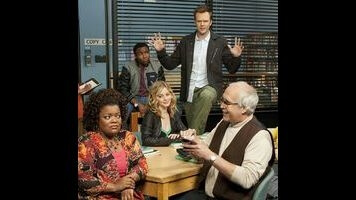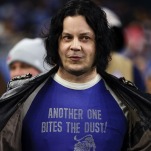“Intro To Knots” just tries too hard. I spent most of my time watching it feeling vaguely uncomfortable, because I knew I was supposed to be having emotional reactions, and I just wasn’t. It was like water off a duck’s back. On the positive side, this means I didn’t really react negatively to it, but it also means the only times I laughed were by and large based on the actors giving a stupid bit of business a funny spin. (Okay, and I laughed at the kittens, because kittens!) It was just there, like air. It was an episode of television that existed, and I watched it, and I spent the whole time wishing it was better, because a crackerjack version of this concept could have been awesome. And, keep in mind, this is an episode that featured a Christmas tree prominently in the background for most of its running time. If anything could save a random episode of television I didn’t like all that much, it would be a Christmas tree.
The basic idea here is to do a riff on the Hitchcock movie Rope. For those of you who haven’t seen it—and you should, because it’s a doozy—the central conceit of the film is that it’s all filmed in “one take,” with the story occurring in real time. (In actuality, Hitchcock employs several cuts, simply because the cameras of the time could not have physically captured the whole film in one go. The camera moves are carefully planned to disguise the cuts, though sometimes—okay, often—inelegantly.) In the story, two men murder a friend, then hide his body in a trunk, upon which dinner is served at a dinner party. The real-time, one-shot, one-set nature of the movie could feel stagey, since this is, after all, based on a play, but the whole thing ends up feeling incredibly tense because the body is onscreen almost the entire time, but none of the other attendees know it. (For another riff on this basic conceit, see The X-Files’ real-time, one-shot episode, “Triangle.”)
The idea in “Intro To Knots” is that much more difficult to set up, and it takes the episode most of the teaser and first act to get there, which robs the story of its momentum. The study group has failed its final history paper, Annie says, and that’s sure to tank them in the class as well. As an attempt to butter him up, she’s invited Cornwallis over for the group’s first grown-up Christmas party at Jeff’s apartment. Through a somewhat convoluted series of events—okay, everybody leaves Chang alone with Cornwallis long enough for Chang to do it—Cornwallis gets tied to a chair, after revealing that the group didn’t receive an F, it received a C-. (Jeff, complaining to Annie about what she’s done, reveals the group’s plan to Cornwallis, who knocks the grade down to an F, prompting Chang tying the old man to a chair.) The reason the group got a C-? Jeff purposely tanked his section so he could see a Tom Waits show, figuring that the others would carry the day. (He simply pasted in the lyrics to “War (What Is It Good For?).”)
What I describe above is, by and large, the first act. It’s not that it’s difficult to follow. Far from it. Andy Bobrow’s script lays out all of the important plot information in a way where it’s absolutely crystal clear what’s happening. Yet this is also the central flaw of the episode: Because the first act is so interested in telling us what’s happening, it gets bogged down in lots and lots of exposition, with too few jokes or moments when the plot is moving forward to compensate. (One moment that does work, in spite of itself: Chang holding up a card to his forehead in front of Cornwallis and asking, “Is this a card?” But that’s all Ken Jeong, and the fact that Chang’s amnesia is imaginary robs it of some of its potency.) The episode ties itself in knots to get itself to the point where Cornwallis is, well, tied in knots, and that makes for a bland, boring first act that goes on far too long and doesn’t offer up enough in the way of enjoyment to compensate. It really saps the momentum of the episode, and it puts the rest of the episode in a hole that it can’t dig its way out of, to say nothing of the problems in the third act.
Fortunately, the second act is much better. With the “stakes” of the episode established (minor though they are), Cornwallis can go about doing exactly what the tied-up character always does: trying to find the weak spots in the armor of the person who tied him up. Instead of turning on Chang, however, he turns on the group, saying that the first person to untie him will receive an A. This is a fairly interesting idea, and it spurs the best stretch of the episode, where Cornwallis points out all of the little fissures in the group’s dynamics and exploits them both for suspense and also for laughs. As I said last week, the best concept episodes of the show work when they work as both episodes of Community and examples of the genres they’re parodying, and this middle section—complete with Abed’s excitement over realizing things are happening in real time—does this with aplomb. It’s not exactly Hitchcock, but it’s playing in sort of the same neighborhood, and it becomes quick and light-footed, unlike the first act.
Unfortunately, the third act and tag sabotage that momentum. It’s not enough to tank everything the second act brought to the episode, but it is enough to ultimately drag the episode back down into the realm of the mediocre. There are some nice ideas here—like the Winger speech involving the idea that all of these people are selfish, but he forgives them for that—but the ultimate reveal (that Chang doesn’t know how to tie knots, and Cornwallis just played along because he hasn’t had a Christmas with other people in years) is pretty dumb, even for a third act revelation of this show. It also undercuts the earlier message of the group being strong enough to withstand even betrayal. And, granted, that was the final revelation of “Cooperative Calligraphy,” the episode this one most resembles, but that revelation was better set-up and more amusing than Chang bumbling. It also doesn’t help that we return to the pointless “Chang is faking and trying to get the study group expelled” bit that was so disappointing before, nor does the final heartwarming bit of opening gifts warm that many hearts. (I’m still trying to make sense of Annie’s line about gift giving and obligation, which sounds nice but doesn’t really mean anything once you start to pull it apart.)
Then the tag is just trying too hard, though at least it has kittens and a certain manic zeal.
If I had to sum up the flaws of this season of Community, it would boil down to trying to do too much. While I know many of you didn’t like the puppet episode—mostly for what were seen as problems with the show’s character continuity—I thought it was a nice, simple story that had some happy moments and a good resolution. (Third acts have always been this show’s biggest problem.) Similarly, “Herstory Of Dance” and “Paranormal Parentage” have relatively straightforward stories that allow for the sorts of character byplay that can make this show so fun. This episode, like too many others this season, tries to cram everything it can think of into the same show, when more simplicity would have led to a stronger episode overall. I don’t really like not loving this episode, since it contains so many of my favorite elements (and kittens!), but I just watched it and wished it could have pared itself down and, in so doing, become even more.
Stray observations:
- When the camera drops the “one shot” bit in act one, it’s rather jarring, as it turns to standard over-the-shoulders and other basic parts of TV sitcom grammar. I was wondering if there was any thought given to shooting the episode all in Rope-style tracking shots, so I asked Andy Bobrow on Twitter, and he said, “I wanted to sooo badly! If you look, most of cold open is one shot. Some v. long shots in act one. I believe in my heart we could have done it, but production was very reluctant. Also that week we had limited availability for Joel [McHale]. Biggest obstacle: had to hit 21.5 minutes. Hitchcock at least had luxury of being able to rehearse for weeks and did not have to hit specific overall length. One thing Tristram [Shapeero, director] did was shoot all with same focal length, which was true of Rope. Shorter answer: Yes, I am absolutely haunted by the belief that Harmon would have insisted, whereas I acquiesced to the restrictions.” (For her part, Megan Ganz chimed in with, “Oof. #sorespot”)
- This is probably just me, since I know a big portion of this show’s audience is in school or young enough to still get worked up over grades, but every time the stakes of the conflict are directly tied to getting a certain grade or getting into a certain class, I tune out a little bit. Why would I care what grade a fictional character gets in his or her class? It’s much more interesting when the show digs into the character conflicts, as it does in the second act.
- Abed’s constant refrains of “Die Hard in a restaurant” were funny enough that I hope the show never tries to do an episode like that.
- Annie coming over early to give Jeff’s apartment her Annie touch made me groan a little bit. A little too reminiscent of her time in that hotel room.
- Troy and Britta’s relationship has apparently progressed to the point where they purchase gifts together. Also: Troy says the word “wassailing” very well.
- This is one of the Chevy Chase-less episodes, which means it has to lean on Chang to be the group instigator. Though I think that having Chase off the show won’t ruin it, I will miss the role Pierce could play within the show’s universe.
- I certainly did not mind seeing a Christmas tree pop up on my TV screen in April. I hope more shows join this growing trend of being delayed to midseason, so all of their holiday episodes air at odd times.






![Rob Reiner's son booked for murder amid homicide investigation [Updated]](https://img.pastemagazine.com/wp-content/avuploads/2025/12/15131025/MixCollage-15-Dec-2025-01-10-PM-9121.jpg)

























![HBO teases new Euphoria, Larry David, and much more in 2026 sizzle reel [Updated]](https://img.pastemagazine.com/wp-content/avuploads/2025/12/12100344/MixCollage-12-Dec-2025-09-56-AM-9137.jpg)








